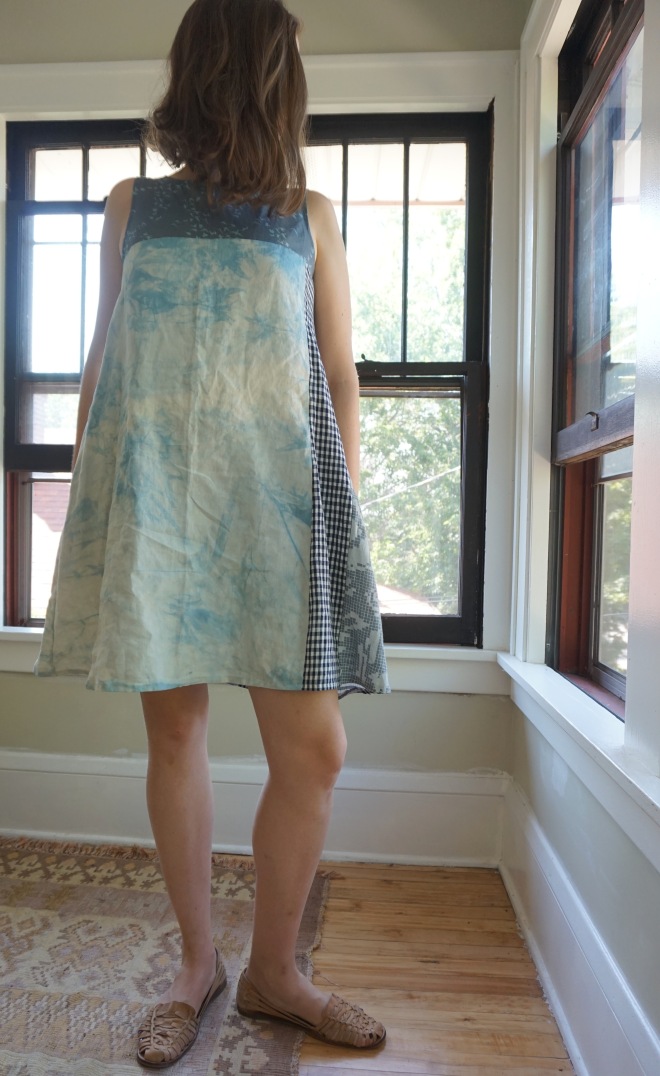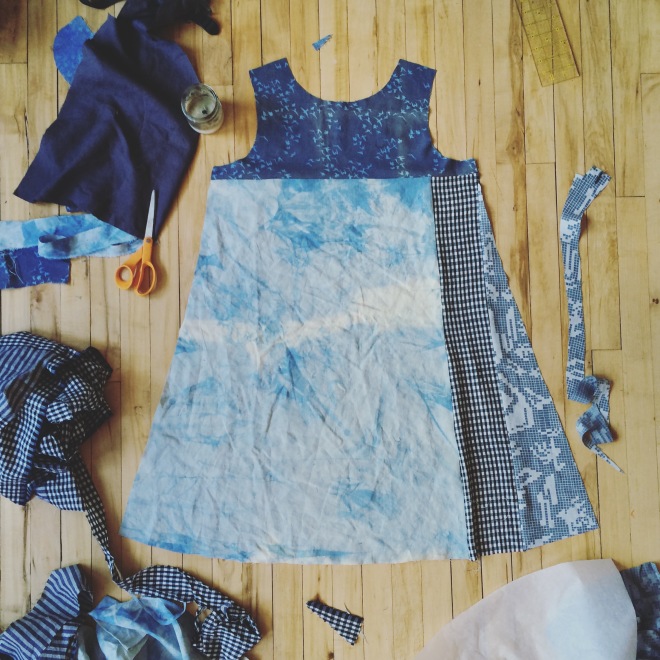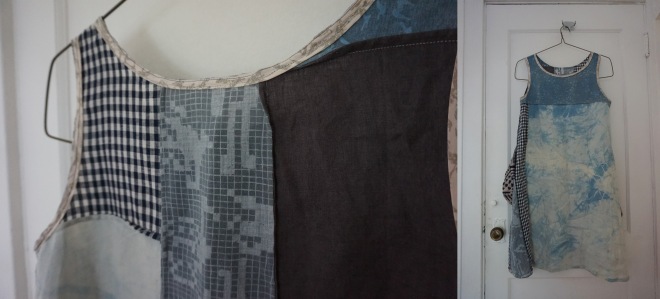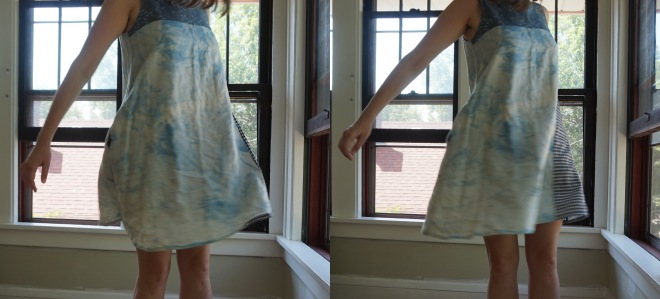
Do you know Sonya Philip’s 100 Acts of Sewing project & patterns? She’s one of those designers/makers who I follow on Instagram and am always eager to see what she’s up to, how she’s styling her makes (see #handmadewardrobechronicles for street style inspiration), and what else she’s discussing – like body positivity and the politics of fast fashion. Her patterns are much like her style – clean lines, comfortable shapes, and infinitely customizable, and I’ve wanted to try them for quite some time. This summer seemed like the perfect time to give Dress No. 1 a try.
As all the rave reviews indicate, Dress No. 1 is a fabulous beginner pattern – it’s just one piece! To be honest, I probably could have drafted a super similar dress on my own, but sometimes I just like supporting what someone else is up to, and I feel like she’s got the fullness of this a-line skirt juuuust right.
I, however, got the fabric for this flat wrong on the first try. It’s quite a saga but let’s just say my natural dye experiments went a little drastic and I now have some scratchy, somber dark khaki mystery fabric (a secondhand find, I suspect it’s cotton, not silk as a handmade label indicated) — suitable for a home decor project some day.
The morning after the fabric flopped (for this dress and the summer wedding I wanted to wear it to), I woke up and peered around my stash. Even though I’m on a stash detox and not buying any new fabric, I contemplated running to the thrift store to see if I could find anything usable. But that seemed like a lot of effort. And I’m trying to really embrace abundance; I have enough — plenty.
So I pulled down my box of scraps, and started laying out the more size-able pieces — you know the oddly shaped 1/4 yard or so that often results from cutting a garment? It always surprises me that there seems to be enough to make another whole (albeit, small) garment, but then I hesitate because I’m reluctant to have an overly matching wardrobe.
I couldn’t find enough of any one fabric to squeeze out the dress, and as soon as I started thinking about piecing together two fabrics, I thought if two why not four? And once I had a vision of a dress pieced in quadrants, I thought, hell, why not full patchwork?
And so my wabi-sabi patchwork dress was born.
Here’s a tip: search “patchwork dress” on Pinterest if you want to make a gypsy costume or enjoy those ’90s handkerchief-hem skirts. Search “indigo patchwork dress” if you want some more refined garment piecing inspiration:
This helped me solidify my vision and get a sense of how to proportion the pieces. I immediately like the off-center approach (as in 1 and 4 above), as opposed to splitting the garment visually down the middle. So I copied the pattern piece onto tracing paper to create a whole piece (instead of the “cut on fold” original) and started laying out fabric on the floor to see what would work where. I should say I also had Felicia Semple’s patchwork dresses somewhere in my mind, and certainly her Stash Less challenge continues to inspire me.
I think it actually helped that I had a (albeit sad, brown) muslin to try on because I could see where different parts of the dress would fall. Mostly I just wanted to avoid awkward lines or cut-offs on the bust.
 Do you ever just get in the creative flow when you stop questioning yourself and start letting your hands carry out your mind & heart’s vision? I tend to overthink things, to work very slowly, but in this case I was both running out of time and running on excitement for getting to touch and admire some of my favorite fabrics again. The large panel on the front and back is linen that I bunched up and dyed in indigo, the gingham is from my khadi Prism dress, the back strip of printed fabric is tencel from Feral Childe (used to make Hudson pants that I adore), the yoke is an indigo-overdyed scrap from my Tamarack Jacket, and there is a solid linen scrap on the back from my vintage wrap skirt. The pockets and bias binding are made of scraps too!
Do you ever just get in the creative flow when you stop questioning yourself and start letting your hands carry out your mind & heart’s vision? I tend to overthink things, to work very slowly, but in this case I was both running out of time and running on excitement for getting to touch and admire some of my favorite fabrics again. The large panel on the front and back is linen that I bunched up and dyed in indigo, the gingham is from my khadi Prism dress, the back strip of printed fabric is tencel from Feral Childe (used to make Hudson pants that I adore), the yoke is an indigo-overdyed scrap from my Tamarack Jacket, and there is a solid linen scrap on the back from my vintage wrap skirt. The pockets and bias binding are made of scraps too!
When I trusted my gut I found that the patchwork came together quite quickly! It helped that I used pretty large pieces, and made a very rough sketch on paper for how to balance the fabrics. There were two important things I kept in mind and prioritized – sort of my mantra for the morning: to align the grain across the fabrics as I pieced them, and to do proper French seams with a good press and trimmed seam allowance each time.

I knew these two factors were important because of my handmade wardrobe reflections, which I was reminded of when I went through the Un-fancy capsule planner. A few of the garments I made two years ago (when my love for making clothes began to flourish) had poor seam finishing and have worn out quickly and had to head to the scrap bin. Another top I made back then, my first patchwork garment ever, looks great on the hanger but awkward on my body because I didn’t pay attention to the grainline of each piece, and as a result the drape is really wonky (which is super noticeable because I used heavier fabrics like mid-weight denim).
While the wabi sabi dress piecing isn’t perfect (that’s why it’s wabi sabi, no?), it’s leaps & bounds above those earlier garments. Everything is finished clean on the inside, including pockets (drafted off my favorite vintage dress) and bias bound neck and arm holes. All together, it’s a scrap-busting success and so fun to twirl in.

Have you made any patchwork clothes? What are your other favorite things to do with scraps?






Love the dress!! Excellent and creative use of your scraps. Your dress has inspired me to take another look at my scrap pile. Cheers Michele
LikeLike
Thank you! Scraps hold so much potential, I hope you make something great 🙂
LikeLike
This is beautiful! I’d wear this all the time. I love that you trusted your gut and just went for it.
LikeLike
Thanks Dani! Just saw your Hannah dress and it looks like the perfect summer frock too!
LikeLike